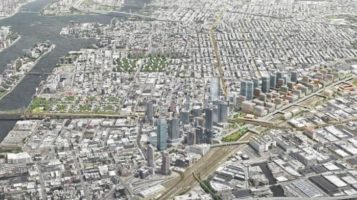
Image Credit: NYC EDC.
The plan calls for 100 percent affordable housing with emphasis on lowest incomes, transportation, new parks and open space. On March 4, 2020, the New York City Economic Development Corporation announced Mayor Bill de Blasio’s and Amtrak’s Sunnyside Yard Master Plan. The Plan’s framework will focus on building new public transit and making all housing affordable, especially for New Yorkers earning less than $50,000 per year. Sunnyside Yard is bounded by Northern Boulevard to the north, Skillman Avenue to the south, Thomson Avenue to the west and 43rd Street to the east. Over the last fifteen years, Western Queens has experienced rapid growth, putting strains on infrastructure, transportation, and housing. The Sunnyside Yard Master Plan presents an opportunity to create nearly 115 acres of new public land by decking over Sunnyside Yard.
The Plan calls for the creation of the Sunnyside Station, 100 percent affordable housing with 12,000 homes, 60 acres of new open space, equitable homeownership opportunities, and infrastructure and other public amenities on a publicly controlled site equal in size to Roosevelt Island.
The Sunnyside Station will serve the growing Long Island City, Woodside and Sunnyside communities. Planning is also in place for a new Rapid Bus Transit line between Queens and Midtown Manhattan.
At least 6,000 affordable homes will be designated for very- and extremely- low income New Yorkers. At least half of the homes will be set aside for families at 50 percent AMI (a family of three earning $48,050 annually) and half will be set aside for families below 30 percent AMI (earning $28,830 annually). Another 6,000 homes will create affordable homeownership opportunities based on the Mitchell-Lama Housing Program, targeting families at 100 percent AMI ($96, 100 annual income). The homeownership program aims to be a generational investment in the neighborhood, and will be New York City’s largest single planned affordable community since the establishment of Co-Op City in the Bronx in the 1970’s.
In 2014, Amtrak approached the City about coordinating on long-term planning for the Yard. In the 2015 State of the City address, the Mayor said that the City would need to work closely with elected officials, community leaders and the railroads to determine what makes sense and ensure that any future overbuild of Sunnyside Yard serves the needs of New Yorkers by delivering on affordable housing, jobs, transportation, social infrastructure and open space.
The City and Amtrak began the Sunnyside Yard master planning process in summer 2018, which comprised of community engagement efforts and detailed technical analysis of rail and deck engineering, infrastructure, urban design, and transportation. A Steering Committee of more than forty community leaders, local and citywide advocates, and policy experts was convened to advise on the planning process and provide critical feedback. The Plan was shaped by feedback from over 100 public interviews, four community workshops, three large public meetings, a digital town hall, walking tours, and group discussions with over 145 organizations to understand community needs.
The Sunnyside Yard Master Plan can be viewed here.
Mayor de Blasio stated, “Sunnyside Yard presents once in a generation opportunity to create a new model for affordable housing and equitable development. With a plan that delivers a new Sunnyside station along with 12,000 affordable homes, equitable homeownership opportunities, open space, schools, and more, we are fighting for a New York New Yorkers can afford.”
Deputy Mayor for Housing and Economic Development Vicki Been stated, “After over a year of extensive community engagements and scores of conversations with a wide range of stakeholders, we developed a thoughtful framework to guide development at Sunnyside Yard for the generations to come. We benefitted enormously from those discussions, and the master plan responds to the feedback by putting neighborhood needs for transit, affordable housing, and open space first, to ensure that future development is responsible, inclusive, and fair.”
By: Laine Vitkevich (Laine is a CityLaw intern and New York Law School student, Class of 2020.)

